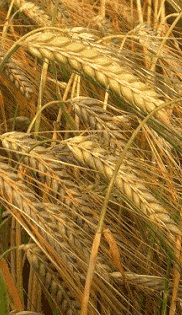 Barley (Hordeum vulgare) is a major cereal grain and a member of the grass family (Poaceae). It is an annual and grows over 36 inches tall so is considered a tall grass. The stems are hairless, often branched at the base, and bear cylindrical bristly seed heads that look like fox tails. Barley is used today for human consumption, animal fodder, and the production of beer and whiskey.
Barley (Hordeum vulgare) is a major cereal grain and a member of the grass family (Poaceae). It is an annual and grows over 36 inches tall so is considered a tall grass. The stems are hairless, often branched at the base, and bear cylindrical bristly seed heads that look like fox tails. Barley is used today for human consumption, animal fodder, and the production of beer and whiskey.
In The Tempest ( act iv, sc. 1, 60 ) Iris, messenger of Juno, implores Ceres to leave her domain and come to perform a masque with Juno to celebrate the engagement of Ferdinand and Miranda.
Ceres, most bounteous lady, thy rich leas
Of wheat, rye, barley, vetches, oats, and peas;
Thy turfy mountains, where live nibbling sheep,
And flat meads thatched with stover, them to keep;
In Henry V (act iii, sc. 5, 18) the French constable describes the food of English soldiers with disgust;
Can sodden water,
A drench for surrein’d jades and their Barley brothe,
Decoct their cold blood to such valiant heat?
The earliest evidence for barley comes from The Fertile Crescent in the Middle East and the area near the Nile, and dates back to 8500 BC. Workers in Knossos on Crete were given allotments of barley, the ancient Roman gladiators ate a special food made of barley, and in the Middle Ages peasants ate bread made of barley. Barley is commonly made into beer and the earliest evidence of beer also comes from the Middle East and dates back to about 5000 BC. Both the ancient Mesopotamians and Egyptians drank beer, monasteries in 7th century Europe made and sold it, and the “Barley brothe” mentioned in Henry V is most probably beer.